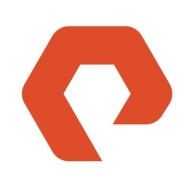


NetApp AFF and NetApp EF-Series All Flash Arrays compete in the storage array market. NetApp AFF seems to have the upper hand in support and user experience, while NetApp EF-Series excels in performance features.
Features: NetApp AFF offers advanced data management, high resilience, and excellent cloud service integration. NetApp EF-Series All Flash Arrays emphasize raw performance, providing rapid data access and minimal latency, which benefits high-demand applications.
Room for Improvement: NetApp AFF could improve scalability and pricing. NetApp EF-Series needs better data management features and enhanced software options.
Ease of Deployment and Customer Service: NetApp AFF provides a straightforward deployment process and robust customer service. NetApp EF-Series All Flash Arrays have fast deployment but some users report a steeper learning curve and less responsive support.
Pricing and ROI: NetApp AFF has higher upfront costs, with users justifying the return on investment through comprehensive features and reliability. NetApp EF-Series All Flash Arrays are recognized for cost-efficiency and delivering quick returns due to their performance.
| Product | Market Share (%) |
|---|---|
| NetApp AFF | 9.4% |
| Pure FlashArray X NVMe | 1.0% |
| NetApp EF-Series All Flash Arrays | 0.7% |
| Other | 88.9% |



| Company Size | Count |
|---|---|
| Small Business | 15 |
| Midsize Enterprise | 11 |
| Large Enterprise | 12 |
| Company Size | Count |
|---|---|
| Small Business | 44 |
| Midsize Enterprise | 46 |
| Large Enterprise | 242 |
| Company Size | Count |
|---|---|
| Small Business | 12 |
| Midsize Enterprise | 10 |
| Large Enterprise | 18 |
Pure Storage FlashArray//X is the world’s first enterprise-class, all-NVMe flash storage array. It represents a new class of storage – shared accelerated storage, which is a term coined by Gartner – that delivers major breakthroughs in performance, simplicity, and consolidation.
The NetApp A-Series and C-Series are AFF storage arrays that deliver high performance, scalability, and simplified data management for a wide range of workloads. They are designed for organizations that need to improve the performance and agility of their applications, while also reducing costs and complexity.
NetApp A-Series and C-Series feature a scale-out architecture that can be scaled to meet the needs of your growing business. They also support a wide range of built-in data protection and data security features, including snapshots, replication, disaster recovery, and autonomous ransomware protection.
AFF A-Series all-flash systems deliver industry-leading performance, density, scalability, security, and network connectivity.
AFF C-Series systems are suited for large-capacity deployment as an affordable way to modernize your data center to all flash and also connect to the cloud.
NetApp AFF Benefits
NetApp AFF Features
Reviews from Real Users
NetApp AFF stands out among its competitors for a number of reasons. Two major ones are its high performance and simplicity. PeerSpot users take note of the advantages of these features in their reviews:
PeerSpot user and Storage Administrator, Daniel Rúnar Friðþjófsson, comments “AFF has helped to simplify our infrastructure, while still getting very high performance for our business-critical applications. Having all these things working well on one solution is really good. We run this as the backbone for both Hyper-V and VMware as well as an archive location for Rubrik. So, it is great having one solution that can do it all.
Because of the ease of it all, you have a highly tunable, high-performance storage system that alleviates a lot of problems. With its ease of management, you can quickly get your work done and go onto the next thing on your list.”
Additionally, Mohan Reddy, Sr. Technology Architect at a Pharma/Biotech company comments on how “NetApp's ONTAP data management software has also made tasks simpler for us. There's no question about that. It has helped us run operations very quickly, saving us a lot of time. Before ONTAP, we used to spend a long time doing regular operations, but with the latest version of the tool, our day-to-day operations are much quicker and easier.”
The NetApp EF560 all-flash array is an all-SSD storage system for applications that demand extremely high levels of performance and reliability. Requiring just 2U of rack space, the EF560 all-flash array combines extreme IOPS, microsecond response times, and up to 12GBps of bandwidth with leading, enterprise-proven availability features.
We monitor all All-Flash Storage reviews to prevent fraudulent reviews and keep review quality high. We do not post reviews by company employees or direct competitors. We validate each review for authenticity via cross-reference with LinkedIn, and personal follow-up with the reviewer when necessary.